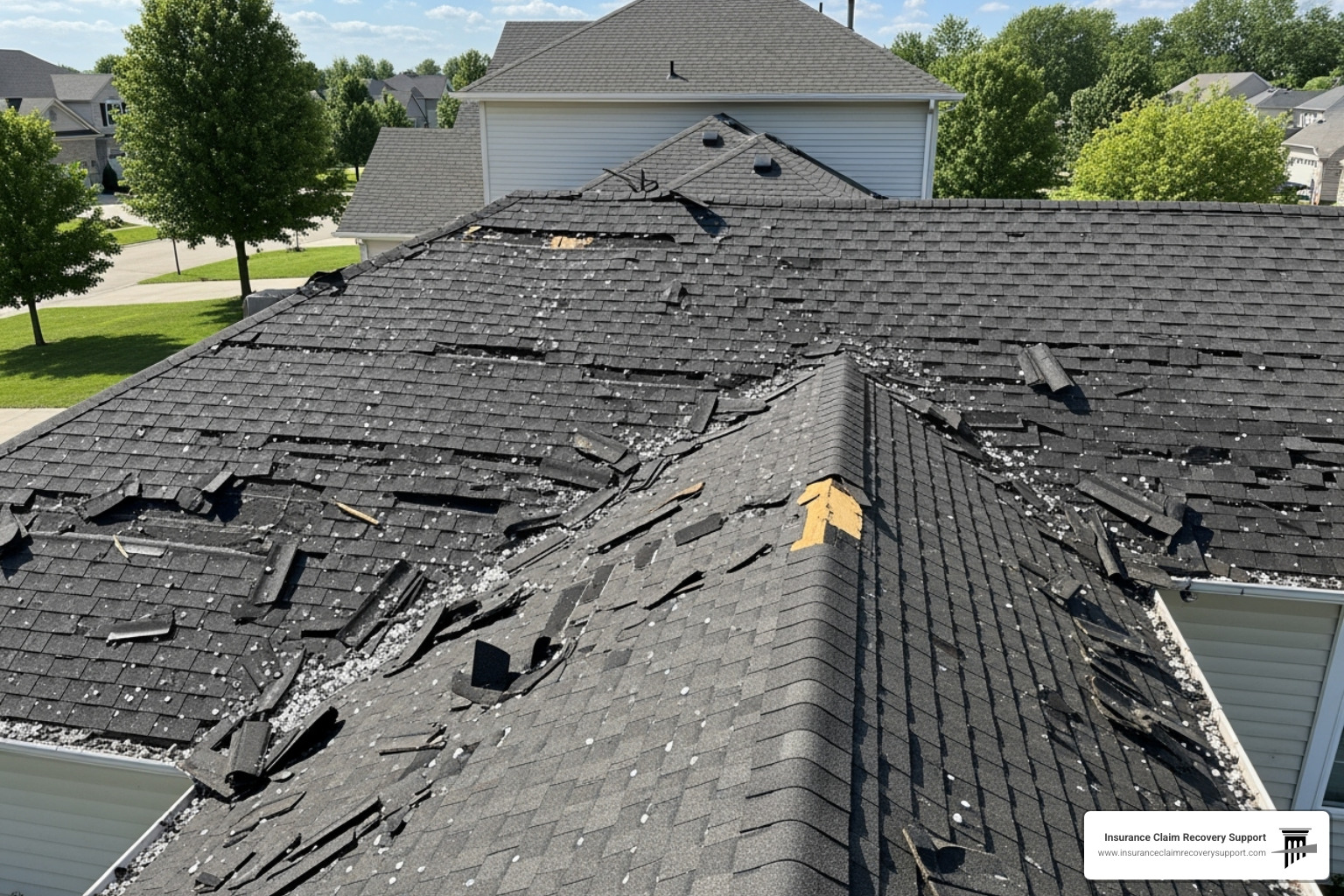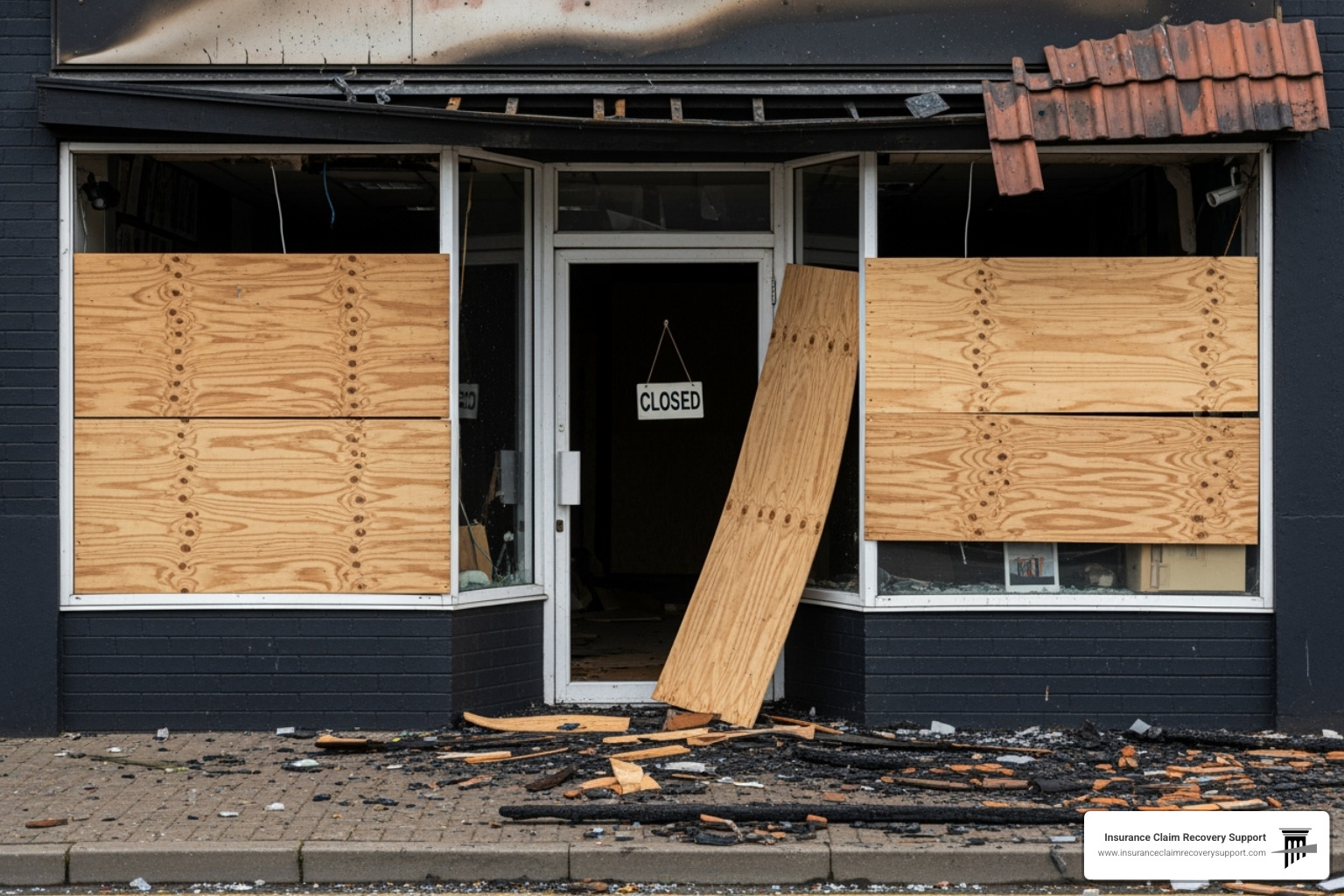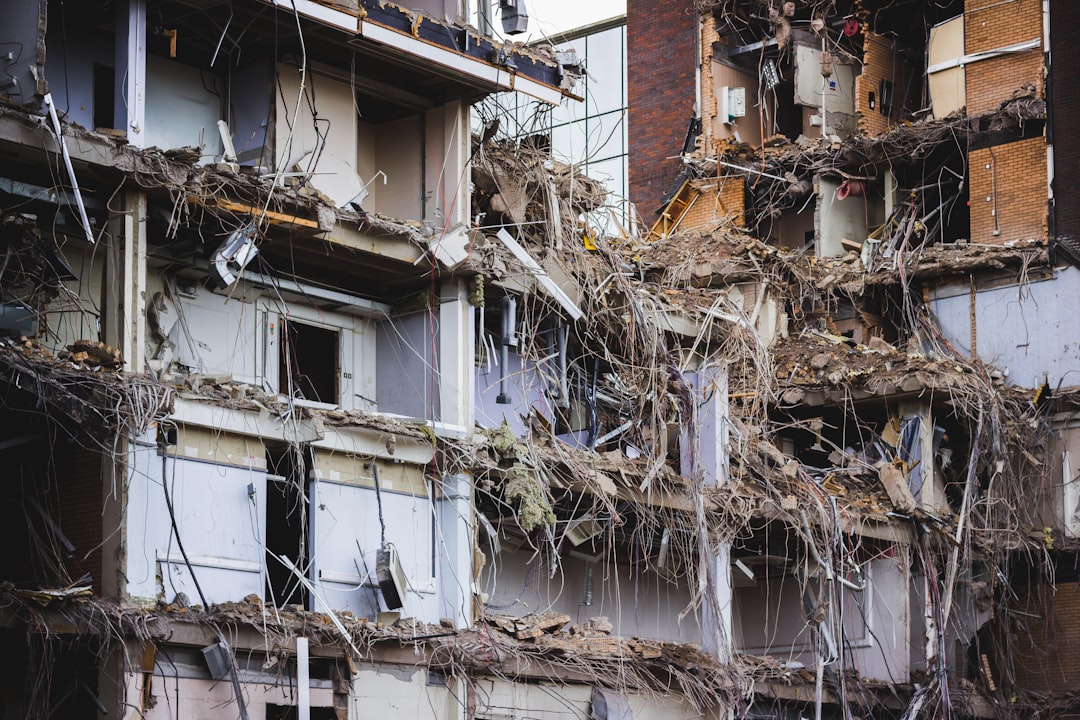Why Hail Damage Claim Disputes Are So Common
A hail damage claim dispute occurs when your insurance company denies, underpays, or delays your hail damage claim, forcing you to challenge their decision. Here’s what you need to know:
Quick Steps to Dispute Your Hail Damage Claim:
- Review the denial letter and identify specific reasons
- Gather evidence – photos, contractor estimates, weather reports
- Get an independent inspection from a qualified professional
- Submit a formal dispute with supporting documentation
- Consider hiring a public adjuster for complex or large claims
- Use the appraisal clause if your policy includes one
- File a complaint with your state insurance department if needed
Hailstorms are a harsh reality for property owners, especially in states like Texas and Colorado where hail damage insurance claims outnumber all other states combined. Between 2016 and 2018 alone, Texas recorded over 811,000 hail damage claims. Yet despite this frequency, many valid claims face denial or underpayment.
The problem isn’t just the storms – it’s what happens after. Insurance companies often use tactics like claiming damage is “cosmetic only,” attributing it to normal wear and tear, or offering lowball settlements that don’t cover actual repair costs. As one frustrated homeowner finded, even when neighbors received full roof replacements, his identical damage was denied as “wear and tear.”
You don’t have to accept your insurer’s first answer. A claim denial is often just the opening move in a negotiation, not the final verdict.
I’m Scott Friedson, a multi-state licensed public adjuster who has settled over 500 large loss claims valued at more than $250 million, including numerous hail damage claim disputes where I’ve overturned wrongful denials and increased settlements by 30% to 3,800%. My experience has shown that most denied hail claims can be successfully challenged with the right approach and documentation.
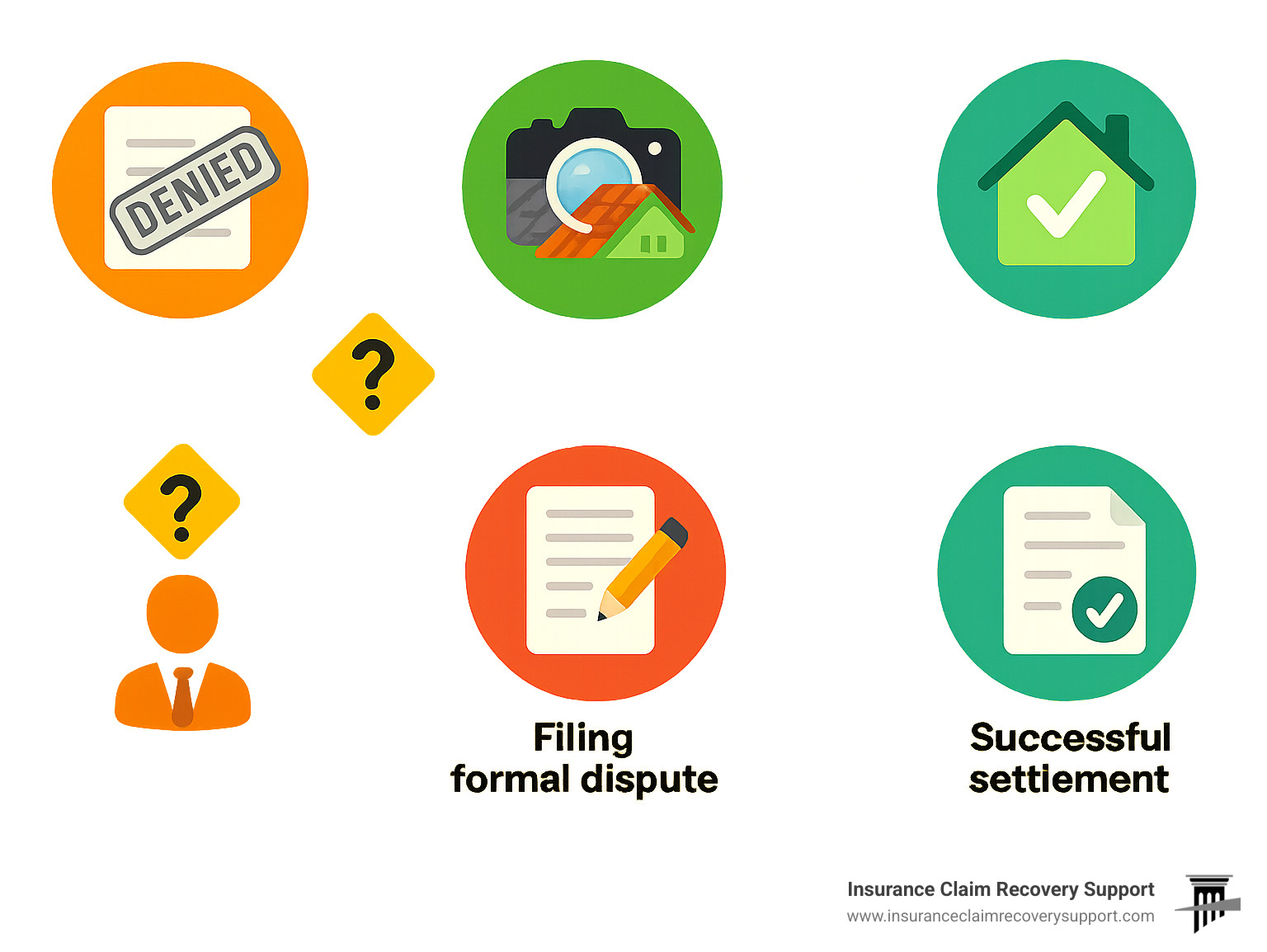
Why Your Hail Damage Claim Was Denied or Underpaid
Getting that denial letter in the mail after a hailstorm feels like getting hit twice. First by the storm, then by your own insurance company. If you’re scratching your head wondering why your claim was denied while your neighbor got a full roof replacement from the same storm, you’re not alone. Hail damage claim disputes happen far too often, especially here in Texas where we see more hail damage than anywhere else in the country.
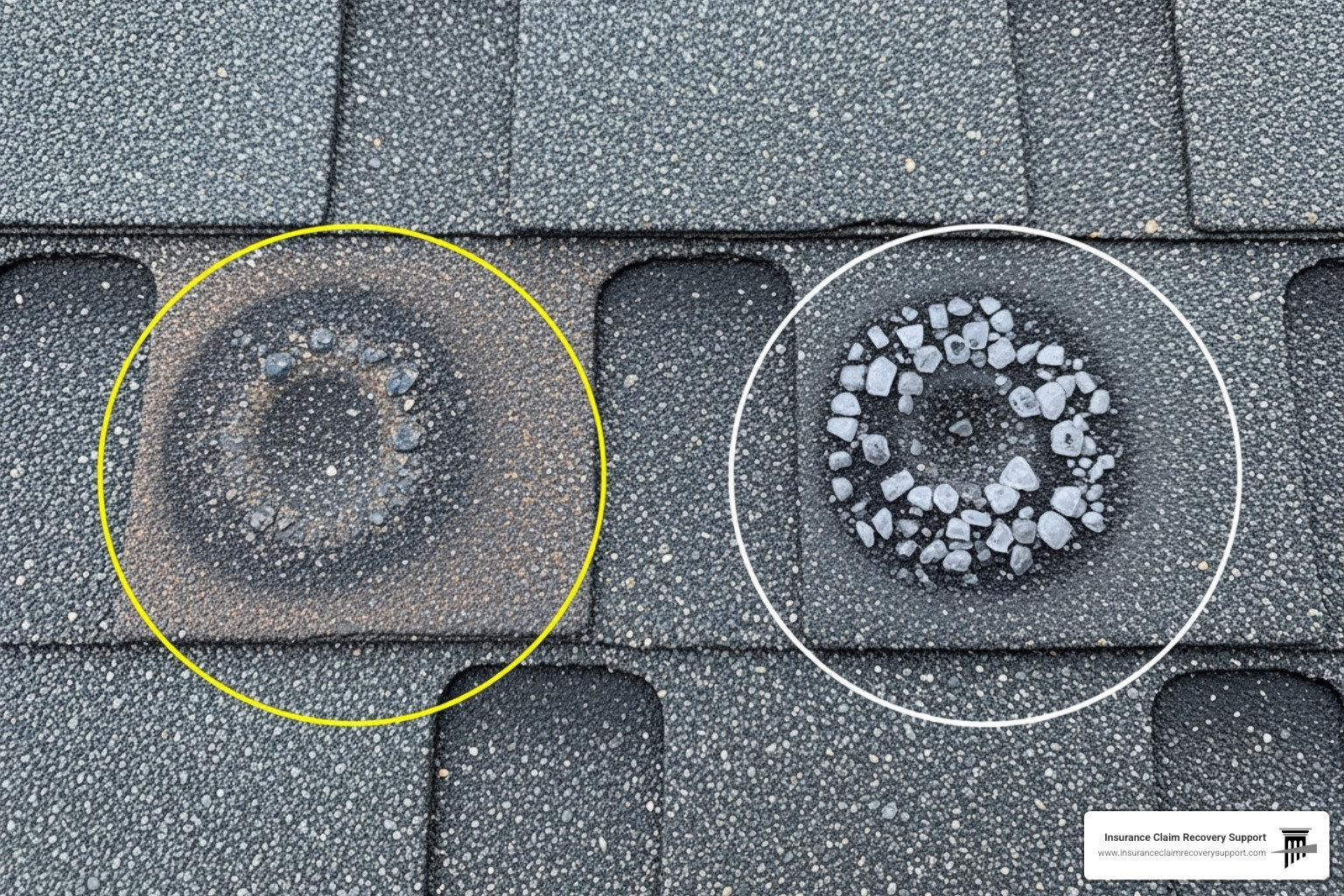
The most common reason for denial? Your insurance company claims the damage is from “wear and tear” rather than hail impact. I’ve seen adjusters look at fresh hail strikes and somehow convince themselves they’re seeing normal aging. It’s like claiming a dent in your car was there before the parking lot mishap – frustrating and often wrong.
Pre-existing damage is another favorite excuse. Insurers love to argue that your roof was already compromised before the storm hit. Sometimes they’re right, but often they’re grasping at straws to avoid paying a legitimate claim.
Then there’s the “cosmetic damage exclusion” – one of the insurance industry’s more creative ways to dodge responsibility. They’ll acknowledge hail hit your roof but claim it only affects appearance, not function. Tell that to your property value and the future leaks that often follow “cosmetic” damage.
Policy time limits catch many property owners off guard. Most policies require you to report damage within one or two years of the storm. Since hail damage isn’t always immediately obvious, especially on commercial buildings, this deadline can sneak up on you.
Insufficient proof is another stumbling block. Without detailed photos, weather data, or proper documentation, even valid claims can be denied. Many property owners don’t realize they need to build a case, not just report damage.
Finally, there are the insurer tactics we see regularly: lowball estimates that wouldn’t cover half your repair costs, inexperienced adjusters who miss significant damage, or staff adjusters who seem more interested in protecting the company’s bottom line than assessing your claim fairly. For a deeper dive into these challenges, check out our guide on Hail and Wind Damage Insurance Claims.
Understanding the Insurer’s Perspective
Here’s the uncomfortable truth: insurance companies are businesses focused on profit, not customer satisfaction. Every dollar they pay out reduces their bottom line, so they’re naturally motivated to minimize payouts.
The adjuster who inspected your property works for the insurance company, not you. Whether they’re a staff adjuster (direct employee) or an independent adjuster (contractor hired by the insurer), their loyalty lies with the company writing their paycheck. This creates an inherent conflict of interest that works against you from day one.
This doesn’t make them evil, but it does mean they approach your claim with a skeptical eye. They’re trained to look for reasons to deny or reduce payments, not to find every bit of damage that needs repair. Understanding this dynamic is crucial when you’re building your case. Learn more about navigating the Hail Damage Claim Process.
Common Policy Exclusions to Watch For
Beyond general denial tactics, specific policy exclusions can blindside even the most prepared property owner.
The cosmetic versus functional damage distinction is particularly troublesome. Many policies now exclude coverage for hail damage that doesn’t compromise your roof’s ability to keep water out. Your roof might look like a golf ball, but if it’s not leaking today, they won’t pay. Never mind that those dents will lead to premature failure and reduced property value.
Matching exclusions create another headache. If your roof shingles or siding materials are discontinued, some policies only require the insurer to replace the damaged section, even if the new materials look completely different. Your property ends up looking like a patchwork quilt, and you’re stuck with the eyesore.
Neglect or lack of maintenance clauses give insurers ammunition to blame you for the damage. If they can argue your roof was already in poor condition, they might deny the entire claim. This is why regular property maintenance isn’t just good practice – it’s claim protection.
Some policies also contain specific peril exclusions that might surprise you. While most standard homeowners policies cover hail, certain endorsements or commercial policies might have unexpected limitations.
For more detailed information about roof-specific coverage issues, visit our Roof Hail Insurance Claim resource.
The good news? Most of these denials can be successfully challenged with the right approach and evidence. A denial letter isn’t the end of the story – it’s just the beginning of your hail damage claim dispute.
Your Immediate Action Plan After a Denial
Receiving a denial letter can feel like a punch to the gut, but it’s not the end of the road. It’s merely the beginning of your hail damage claim dispute. Your immediate actions are critical and can significantly impact the outcome.

First and foremost, don’t panic. Take a deep breath, and then get ready to put on your detective hat. The initial denial is often just the insurer’s opening position, and you have every right to challenge it. We recommend a systematic approach to ensure you’re building the strongest possible case. This involves careful review, meticulous documentation, and strategic communication. Our guide on How to File an Insurance Claim for Storm Damage offers more foundational advice.
Step 1: Analyze the Denial Letter and Your Policy
The denial letter is your first clue. It should state the specific reasons for your claim’s denial. It’s not enough for them to just say “denied.” They must provide a clear explanation.
- Identify Specific Reasons: Is it wear and tear? Cosmetic damage? Lack of maintenance? Policy exclusion? Pinpoint the exact language they use.
- Cross-Reference with Policy Language: Now, pull out your insurance policy – the full document, not just the summary. Read the sections the insurer cites in their denial. Do you agree with their interpretation? Does your policy clearly define “cosmetic” damage? Does it have a matching exclusion? Understanding your policy’s nuances is key to countering their arguments.
- Note All Deadlines: Crucially, the denial letter will often include deadlines for appealing the decision or for submitting additional information. Mark these dates on your calendar immediately. Missing these deadlines can jeopardize your ability to dispute the claim.
Understanding the fine print is vital, and sometimes, navigating these documents can feel like reading a foreign language. If you’re considering professional help, our Texas TDI Public Insurance Adjuster Contract Form offers insights into how we formalize our assistance.
Step 2: Gather and Organize Your Evidence
This is where you build your fortress of facts. The more comprehensive and organized your evidence, the harder it will be for the insurer to maintain their denial.
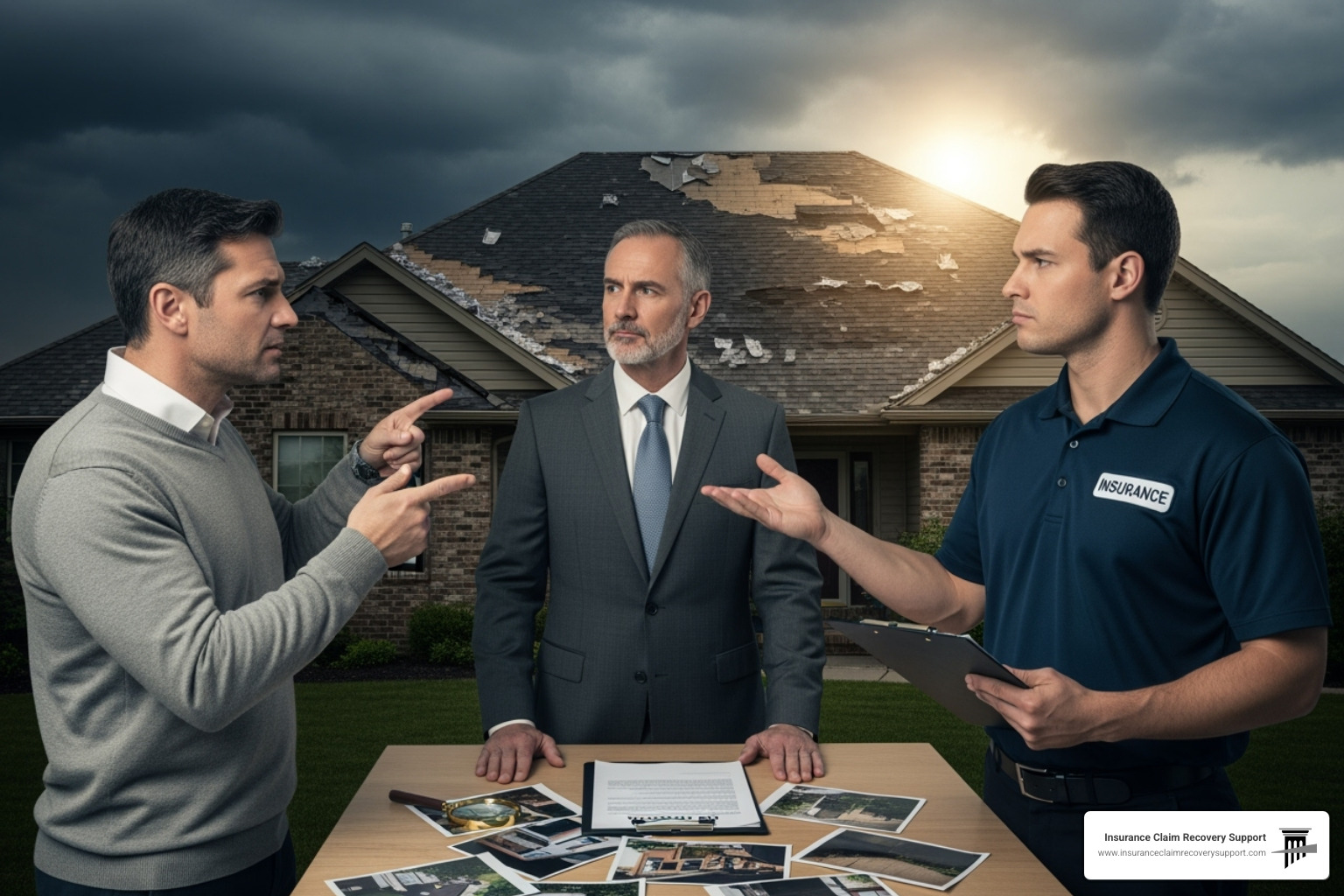
Here’s a list of crucial documents and evidence you should gather:
- Before-and-After Photos: If you have any photos of your property before the hailstorm, they can be invaluable. Compare them directly with photos taken after the storm. Your “after” photos should be clear, high-resolution, and include date and time stamps. Use a common object, like a coin or a ruler, next to the damage to show scale. Capture wide shots of the entire affected area (e.g., the whole roof) and close-ups of individual impacts.
- Contractor Estimates: Obtain at least two, preferably three, independent estimates from reputable, licensed local contractors. Make sure these estimates are detailed, breaking down costs for materials, labor, and any necessary code upgrades. Ensure they specify that the damage is hail-related.
- Weather Data: This is a powerful tool in a hail damage claim dispute. Access historical weather data for the date and time of the storm. Resources like NOAA’s Storm Events Database can provide specific details about hail size, duration, and wind speeds in your exact location. This can counter claims that no significant hailstorm occurred or that the hail wasn’t large enough to cause damage.
- Receipts for Temporary Repairs: If you made any emergency repairs (e.g., tarping a damaged roof to prevent further water intrusion), keep all receipts. These are mitigation expenses that your policy should cover.
- All Correspondence: Keep a meticulous record of every communication with your insurance company – emails, letters, phone call logs (date, time, person you spoke with, summary of conversation). Always follow up phone calls with an email summarizing what was discussed.
The burden of proof often lies with you, the policyholder. The more compelling your evidence, the better your chances of overturning that denial.
Winning Your Hail Damage Claim Dispute: Building an Airtight Case
Once you’ve done your homework and carefully gathered your evidence, it’s time to build an airtight case for your hail damage claim dispute. This involves understanding key policy terms and strategically presenting your findings to turn the tables in your favor.
One of the most critical aspects that often trips up policyholders is understanding the difference between Actual Cash Value (ACV) and Replacement Cost Value (RCV). This distinction can make or break your settlement amount and is frequently at the heart of underpayment disputes.
| Policy Term | Definition | Initial Payout | Depreciation | Final Payout |
|---|---|---|---|---|
| Actual Cash Value (ACV) | The current market value of your damaged property, accounting for age and wear | Replacement cost minus depreciation | Deducted upfront from settlement | You receive the depreciated amount only |
| Replacement Cost Value (RCV) | The full cost to replace damaged property with new materials of similar quality | Initial payment minus depreciation | Recoverable after repairs are completed | You can recover depreciation, getting full replacement cost |
Here’s where it gets interesting: many policyholders don’t realize they’re entitled to depreciation recovery under RCV policies. Your insurer might send you an initial check for the ACV amount, and you might think that’s all you’re getting. Wrong. Once you complete the repairs, you can submit receipts and recover that depreciation – sometimes thousands of dollars more.
Understanding your deductible is equally important. This is your out-of-pocket expense before insurance kicks in. Some insurers try to apply deductibles incorrectly or fail to explain how they work with ACV versus RCV payments. Don’t let them shortchange you on the math.
For insights into typical settlement amounts, check out our guide on Average Insurance Payout for Hail Damage Roof.
Key Steps in a Hail Damage Claim Dispute
The foundation of winning your dispute lies in presenting new, compelling evidence that contradicts the insurer’s denial reasons. Think of this as building a legal case – you need facts, documentation, and expert opinions that are harder to dismiss than your original submission.
Getting an independent assessment is your first power move. The insurance company’s adjuster works for them, not you. Hiring a qualified roofing contractor or professional inspector who can document damage the company adjuster missed gives you fresh ammunition. Make sure this person understands insurance claims and can write a detailed report explaining why the damage is hail-related, not wear and tear.
Hiring a trusted local contractor serves a dual purpose. Not only do they provide repair estimates that reflect actual local costs (often higher than the insurer’s lowball figures), but experienced contractors know how to spot and document hail damage that untrained eyes might miss. They can identify subtle signs like exposed mat on shingles, fractured granules, or damaged gutters that clearly indicate impact damage. Our Contractors resource can help you find qualified professionals.
Presenting new evidence to the insurer requires strategy. Don’t just dump everything on them at once. Organize your evidence logically, address each denial reason specifically, and present a clear narrative that contradicts their position. Include your independent inspection report, detailed contractor estimates, weather data proving a significant hail event occurred, and before-and-after photos that clearly show the damage progression.
Your formal written dispute letter is crucial. This isn’t a casual email – it’s a formal business document that could end up in court. Reference your policy number, claim number, and the specific denial letter you’re disputing. Address each denial reason point by point with your contradicting evidence. Be professional but firm, and always request a written response within a specific timeframe.
Invoking the Appraisal Clause in Your Policy
Here’s a secret weapon many policyholders don’t know they have: the appraisal clause. Most standard homeowners policies include this provision, which allows you to force an independent valuation of your damage when you and the insurer can’t agree on the amount of loss.
The appraisal process works like this: you hire an appraiser, the insurance company hires their own appraiser, and if these two can’t agree, they select a neutral umpire to make the final decision. The process focuses purely on the dollar amount of damage – not whether coverage exists, but how much the covered damage is worth.
Selecting an appraiser is critical. You want someone with specific experience in insurance appraisals and knowledge of your type of damage. Don’t just pick any contractor – choose someone who understands the appraisal process and can present compelling evidence of damage values.
The umpire’s role is to review both appraisers’ findings and make a binding decision on value. When two out of three parties agree (your appraiser and the umpire, or their appraiser and the umpire), that becomes the official damage amount.
This process is a tool to avoid lawsuits – it’s faster and less expensive than court, but still gives you an independent determination of your loss value. For more details on this powerful option, explore our Appraisal Loss Type resource.
The beauty of the appraisal clause is that it levels the playing field. Your insurance company can’t simply dismiss your claim with their adjuster’s opinion – they have to defend their position before independent professionals who understand property damage valuation.
Frequently Asked Questions about Disputing Hail Damage Claims
Let’s be honest – dealing with insurance companies after hail damage can feel like trying to solve a puzzle while blindfolded. You’re not alone in feeling confused or frustrated. We’ve helped hundreds of homeowners through hail damage claim disputes, and certain questions come up again and again. Here are the answers to the most common ones we hear.
How long do I have to file a hail damage claim in Texas?
Time is not your friend when it comes to hail damage claims. In Texas, you typically have two years from the date of loss (the actual hailstorm) to file your claim. But here’s where it gets tricky – your specific policy might have different deadlines that could be much shorter.
Some policies, especially in coastal areas prone to hurricanes, might give you as little as 360 days to report damage. We’ve seen policies with even tighter windows, so don’t assume you have the full two years. Pull out your policy right now and look for the “Notice of Loss” or “Reporting Requirements” section.
Why do we stress acting quickly? Because evidence disappears. Hail melts, temporary repairs get made, and memories fade. The longer you wait, the harder it becomes to prove your damage was caused by that specific storm. Plus, if you miss your policy deadline, you could lose your right to coverage entirely – even if the damage is legitimate.
What is the difference between the insurance company’s adjuster and a public adjuster?
This might be the most important question you can ask, because understanding this difference could save you thousands of dollars.
The insurance company’s adjuster – whether they’re a staff adjuster (direct employee) or an independent adjuster hired by the insurer – works for one client: the insurance company. Their paycheck comes from the same company that’s trying to minimize your payout. While most adjusters are honest people trying to do their job fairly, they’re trained and incentivized to protect the insurer’s bottom line, not maximize your settlement.
Think of it this way: if you were in court, would you want the other side’s lawyer representing you? Of course not.
A public adjuster, on the other hand, works exclusively for you, the policyholder. We’re your advocate, your insurance expert, your negotiator. When you hire us, our only goal is getting you the maximum settlement you deserve. We know the same tricks and tactics the insurance companies use because we’ve been on both sides of these claims.
At Insurance Claim Recovery Support, we’ve seen how this makes a difference. We’ve increased settlements by 30% to 3,800% in cases where policyholders initially tried to handle their hail damage claim dispute alone. For more details about what we do, check out A Public Adjuster.
Can I dispute the amount if the insurer paid but it’s not enough?
Absolutely! This is one of the biggest misconceptions we encounter. Just because your insurance company sent you a check doesn’t mean your claim is closed or that you’ve received what you’re actually owed.
Underpaid claims are incredibly common and represent a significant type of hail damage claim dispute. Insurance companies often make initial payments that seem reasonable but fall short of covering the true cost of repairs. They might miss hidden damage, use outdated pricing, or simply lowball their estimate hoping you’ll accept it.
Here’s what you can do if you believe you’ve been underpaid. First, get detailed contractor estimates that break down the full scope of necessary work. Make sure these estimates account for any damage that wasn’t visible during the initial inspection – things like damaged decking under shingles or interior damage from leaks.
Next, submit a supplemental claim to your insurance company with this new evidence. Present it professionally and clearly explain why the additional payment is justified. This isn’t being greedy – it’s ensuring you receive the coverage you’ve paid for.
Be prepared to negotiate. Insurance companies rarely accept supplemental claims without some back-and-forth. This is where having professional help can make a huge difference. We know how to document damage properly, present evidence effectively, and negotiate from a position of strength.
Accepting that first check doesn’t prevent you from seeking additional compensation if you later find the damage is more extensive than originally thought. Your policy covers the full extent of your covered loss, not just what was found in the first inspection.
The key is acting promptly and professionally. Document everything, get multiple professional opinions, and don’t be afraid to stand up for what you deserve. After all, you’ve been paying premiums specifically for this kind of protection.
Don’t Let a Denial Be the Final Word
When you’re staring at a hail damage claim dispute denial letter, it’s easy to feel defeated. The endless phone calls, confusing policy jargon, and that sinking feeling that you’re being cheated out of what’s rightfully yours can make anyone want to give up. But here’s the truth we want you to remember: a denial is not the end of your story.
Think of that denial letter as your insurance company’s opening bid in a negotiation, not their final answer. We’ve witnessed this scenario play out hundreds of times – what starts as a flat “no” transforms into a fair settlement when policyholders know how to fight back effectively.
You have more power than you realize. By understanding why insurers deny claims, gathering solid evidence, knowing your policy inside and out, and recognizing when to bring in professional help, you shift from being a victim to becoming your own best advocate. This isn’t just about getting your roof fixed – it’s about taking control when a massive corporation tries to shortchange you.
Here in Texas, from the busy streets of Austin and Dallas to the wide-open spaces around Lubbock and San Angelo, we’ve seen too many good people accept lowball offers or outright denials simply because they didn’t know they had other options. Every week, we help policyholders overturn wrongful denials and secure settlements that are 30% to 3,800% higher than initial offers.
At Insurance Claim Recovery Support, we live and breathe hail damage claim disputes. We know exactly which buttons to push and which arguments carry weight with insurance companies because we’ve been in these trenches for years. Whether you’re dealing with storm damage in Fort Worth, hail damage in Houston, or any property damage across the nation, we understand the tactics insurers use – and more importantly, we know how to beat them.
The insurance company is counting on you to accept their first answer and walk away. Don’t give them that satisfaction. Stand up for yourself, gather your evidence, and fight for every dollar you deserve. Your home and your financial future are worth the effort.
We’re not just adjusters – we’re your advocates, and we’re here to level the playing field when David faces Goliath.
Get Your Property Damage Insurance Claim Settled Fairly and Promptly

